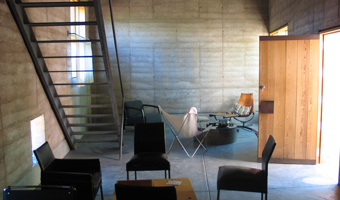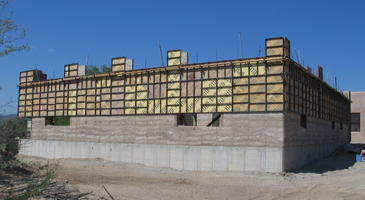



State of the Art: United States
During the spring and summer of 2005 I traveled to the southwestern United States and Europe to meet with a number of successful contemporary architects specifying the technique, as well as the specialized construction firms who carry out the work.
In June 2005 I travelled to Tucson, Arizona to visit Rick Joy Architects, one of the leading design practices specifying rammed earth in the Southwest, to interview Rick Joy and view projects in the area. The interview took place in Joy's rammed earth office and yielded a unique perspective on the dissemination of a technique through current practice. Although the price of rammed earth is competitive with CMU construction in the Tucson area, Joy maintains that cultural issues are as important as the price of construction in determining whether rammed earth is likely to become more widespread in the United States. His projects for high-profile clients may increase the desirability of the technique among a wider public. Nevertheless, Joy is adamant that he is not only a rammed earth architect, asserting that he uses it only when it is appropriate for a particular project and client.
On the same trip I also visited Jones Studio in Phoenix, AZ, another architecture practice utilizing rammed earth. Neil Jones, the principal, expressed frustration with local building inspectors, who treat rammed earth as an experimental construction technique, despite standards governing rammed earth construction. The interview took place in Jones's residence, a striking contemporary load-bearing two-story rammed earth structure which utilizes only natural soils from the site. Jones's refusal to add Portland cement to the soil mix put the project in opposition to the building codes of Arizona, which generally mandate the addition of three percent Portland cement to soil mixes used for rammed earth.
A visit a rammed earth project under construction by a Tucson-based contractor showed that southwestern builders often increase the amount of Portland cement to double the amount specified to avoid a shortage of cement in the mix, which is measured by approximate means in the field. Standard practice in the region is to mix cement with structural road base used in road building, commonly known by the name of "ABC (aggregate base course)" with small hydraulic loaders (e.g. the skidsteer or "Bobcat") and compact it using pneumatic soil backfill tampers. This engineered soil is sometimes mixed with iron oxide or other agents to tint the soil to a desired color. The resultant strength of the soil mixes compacted in this way generally range between 300-800 psi, and building code requires that soil samples generally be tested by a certified engineer prior to the beginning of construction. The project visited utilized modular formwork manufactured for site-cast concrete, with no modification for use with rammed earth.